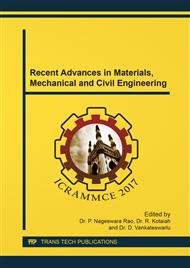[1]
William E. R. Krieger, Sathyanarayanan Raghavan, and Suresh K. Sitaraman, Experiments for Obtaining Cohesive-ZoneParameters for Copper-Mold Compound Interfacial Delamination, IEEE Transaction on Components, Packaging and Manufacturing Technology, Vol4, No: 9, Sep 2016, p.1389.
DOI: 10.1109/tcpmt.2016.2589223
Google Scholar
[2]
Peter A. Gustafson, Anthony M. Waas, The influence of adhesive constitutive parameters in cohesive zone finite element models of adhesively bonded joints, International Journal of Solids and Structures, Vol46, 2009, p.2201-p.2215.
DOI: 10.1016/j.ijsolstr.2008.11.016
Google Scholar
[3]
P.F. Liu and J.Y. Zheng, Recent developments on damage modelling and FE analysis for composite laminates: A review, Materials and Desig, Vol31, 2010, p.3825-p.3834.
DOI: 10.1016/j.matdes.2010.03.031
Google Scholar
[4]
R.D.S.G. Campilho, M.D. Banea , J.A.B.P. Neto , L.F.M. da Silva: Modelling adhesive joints with cohesive zone models: effect of the cohesive law shape of the adhesive layer, International journal of adhesion and adhesives, Vol: 44, p.48-p.56.
DOI: 10.1016/j.ijadhadh.2013.02.006
Google Scholar
[5]
M. D. Thouless and J. P. Parmigiani, Mixed-Mode Cohesive-Zone Models For Delamination and Deflection In Composites, www. personel. umich. edu/~thouless/Riso(2007). pdf.
Google Scholar
[6]
Mohammed Waseem H. S, Kiran Kumar N, Finite Element Modeling for Delamination Analysis of DoubleCantilever Beam Specimen, SSRG International Journal of Mechanical Engg, Vol-1, Issue 5, Sep 2014, p.27-p.33.
Google Scholar
[7]
S. Li, M.D. Thouless, A.M. Waas, J.A. Schroeder, P.D. Zavattieri , Use of a cohesive-zone model to analyze the fracture of a fiber-reinforced polymer–matrix composite, June (2004).
DOI: 10.1016/j.compscitech.2004.08.004
Google Scholar
[8]
Biao Li, Yazhi Li, Jie Su, A New Interface Element for Shell Structures Delamination Analysis", 13th International Conference on Fracture, June 16-21, (2013).
Google Scholar
[9]
U. Stigh, D. Svensson:, On Cohesive Laws For Delamination Of Composites, 14th European Conference on Composite Materials, 7-10-2010, Paper Id: 159-ECCM14.
Google Scholar
[10]
Ever J. Barbero Book on Finite Element Analysis of Composite Materials using ANSYS, Second Edition, 2014 by Taylor & Francis Group, LLC.
Google Scholar
[11]
Alfano, G. and Crisfield, M. A., Finite Element Interface Models for the Delamination Analysis of Laminated Composites: Mechanical and Computational issues, International Journal of Numerical Methods in Engineering, Vol 50, 2001, p.1701-p.1736.
DOI: 10.1002/nme.93
Google Scholar
[12]
K. Senthil, Ph. D thesis, Investigations on structural response of adhesively bonded composite joints, Indian Institute of Technology, Madras, Dec (2015).
Google Scholar


